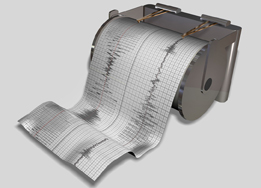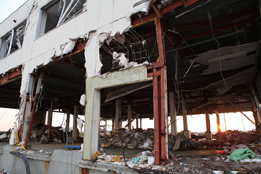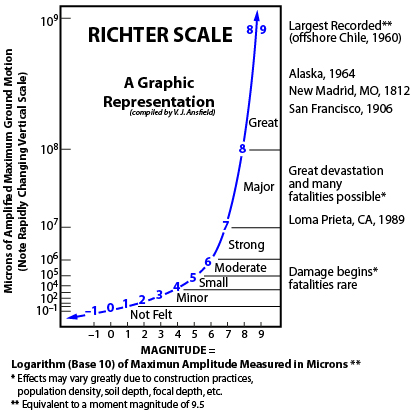Read through “Example 4” on page 377 of the textbook. How does the strategy used in “Example 4” to estimate the value of log2 14 compare with the strategy you used in Try This 4?
Estimate the value of log3 30 to one decimal place. Explain your answer. Answer

iStockphoto/Thinkstock
Logarithms are helpful in different science applications where logarithmic scales are used. In this activity you will explore the Richter scale, which is a logarithmic scale.
Earthquakes produce seismic waves that are recorded on seismographs. The magnitude of an earthquake is determined from the logarithm of the amplitude of the waves recorded on the seismograph. The Richter scale is used to measure the magnitude of an earthquake. Each whole-number increase in magnitude represents an increase of ten times in measured amplitude of the seismic wave.
The relationship between the amplitude of an earthquake and the Richter scale is defined as ![]() , where
, where
Near the east coast of Honshu, Japan, on March 11, 2011, there was a very large earthquake with magnitude 9.0 on the Richter scale. On April 7, 2011, there was an aftershock from the earlier earthquake with magnitude 7.1 on the Richter scale.
![]() Save your responses in your course folder.
Save your responses in your course folder.

iStockphoto/Thinkstock
The Richter scale was created by American Seismologist Charles F. Richter in 1935. The scale measures the shaking of the ground 100 km from the quake’s epicenter. The Richter scale is a logarithmic scale. So, for each whole-number increase on the scale, the magnitude is increased ten-fold. For example, an earthquake that measures 1.0 on the Richter scale will not even be felt by humans, but a quake that registers 4.0 will cause buildings to shake.
An earthquake that registers 8.0 or higher can be catastrophic. The most powerful earthquake ever recorded occurred in Chile in 1960. This quake had a magnitude of 9.5 on the Richter scale. The 2011 earthquake in Japan registered 9.0 on the Richter scale. This earthquake and the resulting tsunami caused incredible damage and loss of life.

Adapted from: © South Dakota Geological Survey